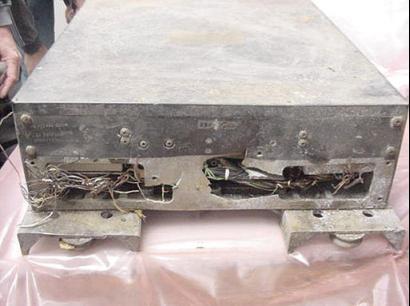The researchers are speeding up the search for the fragments and will try to locate fragments also in a limited but topographically difficult area on the Utah-Nevada border

The data logger discovered this week in Texas may shed light on Columbia's final moments
Columbia disaster investigators are increasing their search of an area of about 12 square kilometers in the border area between Utah and Nevada to try to locate pieces the size of golf balls from the space shuttle Columbia that may provide evidence of what happened to the spacecraft in the February 1 crash.
The mountainous area where the fragments are believed to have fallen has been covered in heavy snow since the Columbia disaster, hindering researchers searching in the area. During the last few weeks, using video photographs, a ground radar interceptor and mathematical calculations, the scientists have narrowed down the search area very much.
The fragments they are looking for are considered vital to the independent investigative team investigating the disaster. Until now, the members of the committee have had difficulty reaching the person who created the crack, this after the fragments they have managed to decipher so far separated from Colombia long after the problems began.
.
Since the disaster, an extensive search has been underway but no wreckage has been found west of Texas. The western fragments found are of two tiles that fell from the shuttle as it flew over New Mexico, Paul Hill, NASA's shuttle flight director, said at a hearing this week as several experts testified before the team investigating the disaster. A video shot by an amateur photographer showed debris coming out of the shuttle when it passed over California, and investigative team member Shelia Widnall said that the debris "must have fallen into the ocean much earlier."
So far fragments representing about 15 or at most 20 percent of the mass of the shuttle have been discovered. Investigators know the shuttle was in trouble long before it reached Texas because the video and telemetry images show the sensors died just before communication was lost.
This week NASA released a video consisting of 15 to 20 different videos. The film shows Columbia as a bright spot out across the California sky, and small flashes appearing almost immediately. As Columbia crosses the planet Venus in the distant background, a brighter flash begins, the flash indicating the sixth part separated from the shuttle. This flash remains in the atmosphere for a long time. Vindal says.
Hill says that the flash was caused by the burning of an aluminum part of the shuttle. Since the relatively light aluminum weighs less than the shuttle, it separates from it and remains suspended in the sky, similar to a piece of paper thrown from a moving car.
Hill says ground-based radar tracked the bone's fall through the atmosphere and it appears to be the same piece seen in the film. He said the object could have been blown by the wind in a general northerly direction, which led investigators to the same five-square-mile search area. William Ilor, a spacecraft reentry specialist at Aerospace Corp. in El Segundo, California, explains that the mass, material composition and thermal strength of each piece represents how far it could travel before reaching the ground.
As a result, he said, objects of different masses fall from the shuttle at different times but may have landed in the same area, making it difficult to locate where each part of the shuttle broke off.
Retired Admiral Harold Gehman, chairman of the investigative team, said senior officials struggled to distinguish damage caused in the original disaster of the Columbia's left wing fire from damage caused after the fragments fell.
Some of the mystery still remains. Gehman said five of the shuttle's six tires remained intact, and two or three of them did look like tires, Gehman said. Ilor, who has overseen the re-entry into the atmosphere of numerous satellites and rockets, said, "I've never seen a spacecraft land with invulnerable rubber until now."
Douglas White, an executive at United Space Alliance, the shuttle's prime contractor, says the sensors on the shuttle were 5 centimeters apart, but they appear to have died within a minute of each other. Another member of the team, Rocher Tetrault commented that in this time frame, a minute is like an eternity.
White said that "we don't have a good theory" about why sensors close to each other showed two different results. He estimated that the system's ability to conduct heat or the way the sensors were connected could make a difference.
White said the periods of communication failure and aerodynamic problems began ten minutes before the control center lost contact with the astronauts for the last time, and the shuttle computer lost contact with the spacecraft.
